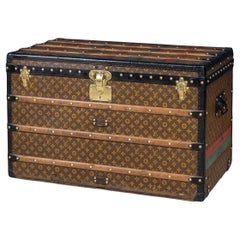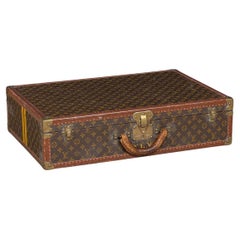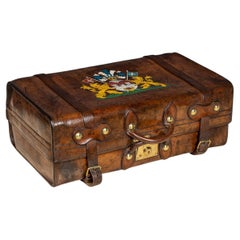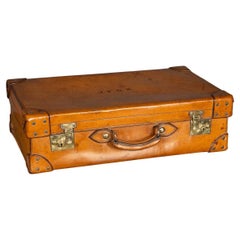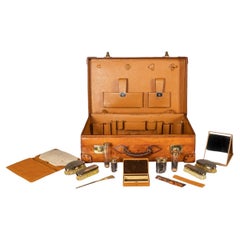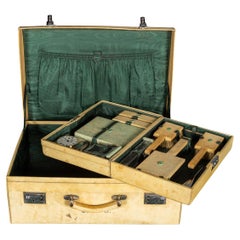Pushkin Antiques Ltd Trunks and Luggage
to
87
86
1
2
1
5
80
1
6
1
2
1
4
1
1
1
1
77
77
73
69
67
87
74
13
1
87
87
87
71
2
1
1
20th Century Louis Vuitton Courier Trunk In Monogram Canvas, France c.1910
By Louis Vuitton
Located in Royal Tunbridge Wells, Kent
Around the turn of the 19th and 20th century Louis Vuitton had established himself as a market leader in trunk making and needed to set his now famous brand apart from the imitators ...
Category
Vintage 1910s French Other Trunks and Luggage
Materials
Leather, Canvas, Wood
20th Century Louis Vuitton Suitcase In Monogram Canvas, France c.1970
By Louis Vuitton
Located in Royal Tunbridge Wells, Kent
A delightful mid to late 20th-century Louis Vuitton hard-sided case, covered with the iconic monogram canvas and complemented by brass fittings. The exterior exudes the unmistakable ...
Category
Vintage 1970s French Other Trunks and Luggage
Materials
Leather, Canvas
Antique 19th Century Victorian Leather Suitcase With Painted Crest c.1850
Located in Royal Tunbridge Wells, Kent
Antique mid-19th Century Victorian leather suitcase with a painted family crest. The suitcase is very well kept and features the original cotton lining, document holder and dust cove...
Category
Antique 1850s British Victorian Trunks and Luggage
Materials
Brass
Antique 19thC English Leather Overnight Case With Six Silver Topped Jars c.1881
Located in Royal Tunbridge Wells, Kent
Antique 19th Century English bridle leather overnight case, containing six different shaped glass vanity jars topped with solid silver lids, dating to 1881. Inside the case there als...
Category
Antique 1880s British Other Trunks and Luggage
Materials
Brass
An Edwardian Dressing Case With Silver Accessories By Walker & Hall c.1928
By John Edward Bingham (Walker and Hall)
Located in Royal Tunbridge Wells, Kent
An English bridle hide dressing case with gilded silver accessories marked with the Walker and Hall stamp and a delicate engine turned pattern, including brushes, jars, mirror and do...
Category
Vintage 1920s British Other Trunks and Luggage
Materials
Brass
Antique 20th Century Vellum Overnight Case By Royal Doulton c.1920
By Royal Doulton
Located in Royal Tunbridge Wells, Kent
Antique 20th-century English suitcase crafted from luxurious vellum, accompanied by a compact interior vanity case, offers versatility for both joint and individual use. Adorned with...
Category
20th Century British Other Trunks and Luggage
Materials
Silk
20th Century Louis Vuitton Suitcase In Natural Cow Hide, France c.1910
By Louis Vuitton
Located in Royal Tunbridge Wells, Kent
A highly unusual and exceptionally rare Louis Vuitton suitcase, originating from the early years of the 20th century, distinguishes itself not with the globally renowned monogram canvas but with a distinctive covering crafted from a singular piece of cowhide. This unique piece represents a special order from Louis Vuitton, showcasing the brand's historical commitment to utilising only the finest hides available.
Unlike many of its counterparts, leather trunks and cases of this era often struggle to withstand the test of time, requiring regular treatments to prevent drying and disintegration. Remarkably, this particular example defies the odds, retaining the same supple quality it possessed on the day it first graced the shop floor. This suitcase belongs to Louis Vuitton's collection of "speciality materials," which encompasses a diverse range, including, but not limited to, zinc, copper, crocodile leather, and cow leather.
A brief history about Louis Vuitton trunks: Louis Vuitton was born in 1821 to a farmer and milliner and came from a long-established working-class family in eastern France. Vuitton grew up understanding the effects of perseverance and a strong work ethic from watching his family. At the age of 16, he made the decision to walk 292 miles from his hometown to Paris to try and make a new life for himself. When he arrived the city was in the midst of industrialization with current modes of transportation evolving quickly allowing for longer journeys. With this came the need for sturdy travel pieces.
Vuitton was taken as an apprentice for a successful box maker and packer named Monsieur Marechal. He learned to craft durable containers and how to pack them properly – a well-respected profession at the time.In 1854, years after he had mastered his craft and became well respected for it, Vuitton ventured out on his own to open a shop on Rue Neuve des Capucines. It was here that he began to establish himself as a luggage maker. Then, in 1858, Vuitton designed the first Louis Vuitton steamer trunk. At the time trunks had rounded tops to allow for water to run off but this did not allow for convenient stowage. Vuitton introduced a flat, yet waterproof, trunk that was easily stackable. The first of his trunks were outfitted with a grey canvas referred to as Trianon – it wouldn’t be until several decades later that the signature monogram would be introduced.
With a burgeoning business, Vuitton moved his family and workplace to Asniere, where he employed twenty workers to craft his trunks. By 1900 he would have 100 employees, and in 1914 the company would more than double in size. After years of success, Vuitton began to experiment with the design of his luggage by introducing a new striped canvas pattern (1876) and later the still well-known Damier print (1888). The hand-painted patterns were developed to prevent counterfeits. Even in the late 1800s, Louis Vuitton was enough of a status symbol to warrant counterfeiting. In 1886, his son George invented and patented an ingenious locking system that made it impossible to pick the lock of their trunks. This lock is still used today.
1892 would prove to be a time of mourning for the family as Louis Vuitton passed...
Category
20th Century French Other Trunks and Luggage
Materials
Brass
20th Century Louis Vuitton Cow Hide Suitcase, France c.1920
By Louis Vuitton
Located in Royal Tunbridge Wells, Kent
A highly unusual and exceptionally rare Louis Vuitton suitcase, originating from the early years of the 20th century, distinguishes itself not with the globally renowned monogram canvas but with a distinctive covering crafted from a singular piece of cowhide. This unique piece represents a special order from Louis Vuitton, showcasing the brand's historical commitment to utilizing only the finest hides available.
Unlike many of its counterparts, leather trunks and cases of this era often struggle to withstand the test of time, requiring regular treatments to prevent drying and disintegration. Remarkably, this particular example defies the odds, retaining the same supple quality it possessed on the day it first graced the shop floor. This suitcase belongs to Louis Vuitton's collection of "speciality materials," which encompasses a diverse range, including, but not limited to, zinc, copper, crocodile leather, and cow leather.
A brief history about Louis Vuitton trunks: Louis Vuitton was born in 1821 to a farmer and milliner and came from a long-established working-class family in eastern France. Vuitton grew up understanding the effects of perseverance and a strong work ethic from watching his family. At the age of 16, he made the decision to walk 292 miles from his hometown to Paris to try and make a new life for himself. When he arrived the city was in the midst of industrialization with current modes of transportation evolving quickly allowing for longer journeys. With this came the need for sturdy travel pieces.
Vuitton was taken as an apprentice for a successful box maker and packer named Monsieur Marechal. He learned to craft durable containers and how to pack them properly – a well-respected profession at the time.In 1854, years after he had mastered his craft and became well respected for it, Vuitton ventured out on his own to open a shop on Rue Neuve des Capucines. It was here that he began to establish himself as a luggage maker. Then, in 1858, Vuitton designed the first Louis Vuitton steamer trunk. At the time trunks had rounded tops to allow for water to run off but this did not allow for convenient stowage. Vuitton introduced a flat, yet waterproof, trunk that was easily stackable. The first of his trunks were outfitted with a grey canvas referred to as Trianon – it wouldn’t be until several decades later that the signature monogram would be introduced.
With a burgeoning business, Vuitton moved his family and workplace to Asniere, where he employed twenty workers to craft his trunks. By 1900 he would have 100 employees, and in 1914 the company would more than double in size. After years of success, Vuitton began to experiment with the design of his luggage by introducing a new striped canvas pattern (1876) and later the still well-known Damier print (1888). The hand-painted patterns were developed to prevent counterfeits. Even in the late 1800s, Louis Vuitton was enough of a status symbol to warrant counterfeiting. In 1886, his son George invented and patented an ingenious locking system that made it impossible to pick the lock of their trunks. This lock is still used today.
1892 would prove to be a time of mourning for the family as Louis Vuitton passed...
Category
20th Century French Other Trunks and Luggage
Materials
Brass
20th Century Louis Vuitton Cow Hide Suitcase, France c.1920
By Louis Vuitton
Located in Royal Tunbridge Wells, Kent
A highly unusual and exceptionally rare Louis Vuitton suitcase, originating from the early years of the 20th century, distinguishes itself not with the globally renowned monogram canvas but with a distinctive covering crafted from a singular piece of cowhide. This unique piece represents a special order from Louis Vuitton, showcasing the brand's historical commitment to utilizing only the finest hides available.
Unlike many of its counterparts, leather trunks and cases of this era often struggle to withstand the test of time, requiring regular treatments to prevent drying and disintegration. Remarkably, this particular example defies the odds, retaining the same supple quality it possessed on the day it first graced the shop floor. This suitcase belongs to Louis Vuitton's collection of "speciality materials," which encompasses a diverse range, including, but not limited to, zinc, copper, crocodile leather, and cow leather.
A brief history about Louis Vuitton trunks: Louis Vuitton was born in 1821 to a farmer and milliner and came from a long-established working-class family in eastern France. Vuitton grew up understanding the effects of perseverance and a strong work ethic from watching his family. At the age of 16, he made the decision to walk 292 miles from his hometown to Paris to try and make a new life for himself. When he arrived the city was in the midst of industrialization with current modes of transportation evolving quickly allowing for longer journeys. With this came the need for sturdy travel pieces.
Vuitton was taken as an apprentice for a successful box maker and packer named Monsieur Marechal. He learned to craft durable containers and how to pack them properly – a well-respected profession at the time.In 1854, years after he had mastered his craft and became well respected for it, Vuitton ventured out on his own to open a shop on Rue Neuve des Capucines. It was here that he began to establish himself as a luggage maker. Then, in 1858, Vuitton designed the first Louis Vuitton steamer trunk. At the time trunks had rounded tops to allow for water to run off but this did not allow for convenient stowage. Vuitton introduced a flat, yet waterproof, trunk that was easily stackable. The first of his trunks were outfitted with a grey canvas referred to as Trianon – it wouldn’t be until several decades later that the signature monogram would be introduced.
With a burgeoning business, Vuitton moved his family and workplace to Asniere, where he employed twenty workers to craft his trunks. By 1900 he would have 100 employees, and in 1914 the company would more than double in size. After years of success, Vuitton began to experiment with the design of his luggage by introducing a new striped canvas pattern (1876) and later the still well-known Damier print (1888). The hand-painted patterns were developed to prevent counterfeits. Even in the late 1800s, Louis Vuitton was enough of a status symbol to warrant counterfeiting. In 1886, his son George invented and patented an ingenious locking system that made it impossible to pick the lock of their trunks. This lock is still used today.
1892 would prove to be a time of mourning for the family as Louis Vuitton passed...
Category
20th Century French Other Trunks and Luggage
Materials
Brass
20th Century Louis Vuitton Trunk, France c.1930
By Louis Vuitton
Located in Royal Tunbridge Wells, Kent
An exquisite and complete Louis Vuitton trunk from the early part of the 20th century. An absolutely essential item for elite travellers of its time the trunk is adorned in the iconic LV monogrammed canvas, accented by lozine trim and brass fittings. This trunk stood as the epitome of luxury over 100 years ago, boasting an unparalleled level of sophistication and elegance, it remains a timeless masterpiece that transcends eras.
The captivating allure of the Louis Vuitton trunk transforms it into more than a mere luggage accessory; it becomes a focal point for any room. With its impressive dimensions, it is perfectly suited as a striking coffee table, side table, or even as a standalone centrepiece, seamlessly integrating into any interior, whether modern or traditional. An extraordinary piece that not only pays homage to the past but also serves as a statement of unparalleled luxury in the present.
A brief history about Louis Vuitton trunks: Louis Vuitton was born in 1821 to a farmer and milliner and came from a long-established working-class family in eastern France. Vuitton grew up understanding the effects of perseverance and a strong work ethic from watching his family. At the age of 16, he made the decision to walk 292 miles from his hometown to Paris to try and make a new life for himself. When he arrived the city was in the midst of industrialization with current modes of transportation evolving quickly allowing for longer journeys. With this came the need for sturdy travel pieces.
Vuitton was taken as an apprentice for a successful box maker and packer named Monsieur Marechal. He learned to craft durable containers and how to pack them properly – a well-respected profession at the time.In 1854, years after he had mastered his craft and became well respected for it, Vuitton ventured out on his own to open a shop on Rue Neuve des Capucines. It was here that he began to establish himself as a luggage maker. Then, in 1858, Vuitton designed the first Louis Vuitton steamer trunk. At the time trunks had rounded tops to allow for water to run off but this did not allow for convenient stowage. Vuitton introduced a flat, yet waterproof, trunk that was easily stackable. The first of his trunks were outfitted with a grey canvas referred to as Trianon – it wouldn’t be until several decades later that the signature monogram would be introduced.
With a burgeoning business, Vuitton moved his family and workplace to Asniere, where he employed twenty workers to craft his trunks. By 1900 he would have 100 employees, and in 1914 the company would more than double in size. After years of success, Vuitton began to experiment with the design of his luggage by introducing a new striped canvas pattern (1876) and later the still well-known Damier print (1888). The hand-painted patterns were developed to prevent counterfeits. Even in the late 1800s, Louis Vuitton was enough of a status symbol to warrant counterfeiting. In 1886, his son George invented and patented an ingenious locking system that made it impossible to pick the lock of their trunks. This lock is still used today.
1892 would prove to be a time of mourning for the family as Louis Vuitton passed...
Category
20th Century French Other Trunks and Luggage
Materials
Brass
20th Century Louis Vuitton Trunk In Monogram Canvas, France c.1930
By Louis Vuitton
Located in Royal Tunbridge Wells, Kent
An exquisite and complete Louis Vuitton trunk from the early part of the 20th century. An absolutely essential item for elite travellers of its time the trunk is adorned in the iconic LV monogrammed canvas, accented by lozine trim and brass fittings. This trunk stood as the epitome of luxury over 100 years ago, boasting an unparalleled level of sophistication and elegance, it remains a timeless masterpiece that transcends eras.
The captivating allure of the Louis Vuitton trunk transforms it into more than a mere luggage accessory; it becomes a focal point for any room. With its impressive dimensions, it is perfectly suited as a striking coffee table, side table, or even as a standalone centrepiece, seamlessly integrating into any interior, whether modern or traditional. An extraordinary piece that not only pays homage to the past but also serves as a statement of unparalleled luxury in the present.
A brief history about Louis Vuitton trunks: Louis Vuitton was born in 1821 to a farmer and milliner and came from a long-established working-class family in eastern France. Vuitton grew up understanding the effects of perseverance and a strong work ethic from watching his family. At the age of 16, he made the decision to walk 292 miles from his hometown to Paris to try and make a new life for himself. When he arrived the city was in the midst of industrialization with current modes of transportation evolving quickly allowing for longer journeys. With this came the need for sturdy travel pieces.
Vuitton was taken as an apprentice for a successful box maker and packer named Monsieur Marechal. He learned to craft durable containers and how to pack them properly – a well-respected profession at the time.In 1854, years after he had mastered his craft and became well respected for it, Vuitton ventured out on his own to open a shop on Rue Neuve des Capucines. It was here that he began to establish himself as a luggage maker. Then, in 1858, Vuitton designed the first Louis Vuitton steamer trunk. At the time trunks had rounded tops to allow for water to run off but this did not allow for convenient stowage. Vuitton introduced a flat, yet waterproof, trunk that was easily stackable. The first of his trunks were outfitted with a grey canvas referred to as Trianon – it wouldn’t be until several decades later that the signature monogram would be introduced.
With a burgeoning business, Vuitton moved his family and workplace to Asniere, where he employed twenty workers to craft his trunks. By 1900 he would have 100 employees, and in 1914 the company would more than double in size. After years of success, Vuitton began to experiment with the design of his luggage by introducing a new striped canvas pattern (1876) and later the still well-known Damier print (1888). The hand-painted patterns were developed to prevent counterfeits. Even in the late 1800s, Louis Vuitton was enough of a status symbol to warrant counterfeiting. In 1886, his son George invented and patented an ingenious locking system that made it impossible to pick the lock of their trunks. This lock is still used today.
1892 would prove to be a time of mourning for the family as Louis Vuitton passed...
Category
20th Century French Other Trunks and Luggage
Materials
Brass
20th Century Louis Vuitton Shoe Trunk, France c.1930
By Louis Vuitton
Located in Royal Tunbridge Wells, Kent
A magnificent and exceptionally rare Louis Vuitton shoe trunk, adorned with stencilled monogram canvas, lozine trim and brass fittings. Elevating its uniqueness is the remarkably uncommon size that distinguishes it from standard models. This extraordinary piece measures an impressive 90cm in length, an astounding 50% wider than the already scarce shoe trunks typically encountered. Dating back to the first half of the 20th century, this trunk was an indispensable possession for discerning elite travellers, evoking the grandeur of passenger ships and the first-class luxury of bygone eras.
Designed with the utmost attention to detail, this rare find is equipped with its original lift-out trays, showcasing the timeless craftsmanship that has come to define Louis Vuitton...
Category
20th Century French Other Trunks and Luggage
Materials
Brass
20th Century English Leather Trunk On Metal Stand, c.1910
Located in Royal Tunbridge Wells, Kent
Antique early 20th Century trunk, lined with the original fabric in a champagne colour. This trunk comes with original polished metal locks and leather handles. Applied on the trunk ...
Category
20th Century British Trunks and Luggage
Materials
Metal
20th Century English Leather Trunk On Metal Stand, c1910
Located in Royal Tunbridge Wells, Kent
Antique early 20th Century trunk on stand, the inside is lined fabric in a rich burgundy colour, beautifully offsetting the outside natural tan hide colour of the trunk. This trunk c...
Category
20th Century British Trunks and Luggage
Materials
Metal
20th Century Louis Vuitton Trunk In Monogram Canvas, France, c.1900
By Louis Vuitton
Located in Royal Tunbridge Wells, Kent
Gorgeous and most importantly complete, this early 20th century Louis Vuitton trunk was the must have item of any elite traveller. Covered in the world famous LV monogrammed canvas, ...
Category
20th Century French Trunks and Luggage
Materials
Brass
20th Century Louis Vuitton "Malle Haute" In Monogram Canvas, France, c.1910
By Louis Vuitton
Located in Royal Tunbridge Wells, Kent
An exquisite “malle haute“ (tall trunk) by Louis Vuitton, early 20th century. The malle haute is the largest of the standard sizes, any trunk larger than this one would have been cus...
Category
20th Century French Trunks and Luggage
Materials
Brass
20th Century British Made Bridle Leather Suitcase, c.1910
Located in Royal Tunbridge Wells, Kent
Antique early 20th Century British made Bridle hide covered suitcase. The leather shows wear but is still supple, mounted with brass fittings, oozing charm and elegance. A truly grea...
Category
20th Century British Trunks and Luggage
Materials
Leather
20th Century Revelation Expanding Leather Suitcase, c.1920
Located in Royal Tunbridge Wells, Kent
Antique early 20th Century Bridle Hide Revelation expanding leather suitcase, a hallmark of innovation from the 1920's, showcased a pioneering design that allowed for adjustable stor...
Category
20th Century British Trunks and Luggage
Materials
Brass
20th Century British Made Bridle Leather Suitcase, c.1910
Located in Royal Tunbridge Wells, Kent
Antique early 20th Century British made Bridle hide covered suitcase. The leather shows wear but is still supple, mounted with brass fittings, oozing charm and elegance. A truly grea...
Category
20th Century British Trunks and Luggage
Materials
Leather
19th Century Victorian Dressing Case By W Insall & Sons, c.1890
Located in Royal Tunbridge Wells, Kent
An antique 19th Century victorian dressing case in English bridle leather by W Insall of Birmingham. This piece is lined in green baize with or...
Category
Antique 19th Century British Victorian Trunks and Luggage
Materials
Leather
20th Century Louis Vuitton "President" Briefcase In Monogram Canvas, France
By Louis Vuitton
Located in Royal Tunbridge Wells, Kent
A charming Louis Vuitton hard-sided case, late 20th century, the exterior finished in the famous monogram canvas with brass fittings. This beautiful example is in fantastic condition...
Category
20th Century French Trunks and Luggage
Materials
Brass
20th Century Louis Vuitton Trunk in Damier Canvas, Paris, C.1900
By Louis Vuitton
Located in Royal Tunbridge Wells, Kent
One of the rarest Louis Vuitton trunks to be offered, this trunk is covered in the world famous damier (checkerboard) canvas. Dating to around 1900, it is a perfect example of such trunks. With its leather trim, brass studs, fittings and locks it still shows the same elegance as it did well over 100 years ago and is a testament to the durability of the best trunk maker in the world.
Today it makes for a wonderful piece of interior design, both decorative and useful. This particular example has very unusual proportions, measuring 70cm in height but a narrower 90cm in width. Usually trunks with a height of 70cm have a width of 110cm, so quite possibly this trunk was a special order made for Mr or Mrs Waters. The lettering on both sides are original from the Louis Vuitton factory...
Category
20th Century French Trunks and Luggage
Materials
Brass
20th Century Louis Vuitton Cabin Trunk In Natural Cow Hide, Paris, c.1910
By Louis Vuitton
Located in Royal Tunbridge Wells, Kent
A rare Louis Vuitton cabin trunk covered in leather. Dating to the early part of the 20th century, covered not in the world famous (but more common) monogram canvas but in a single piece of cow hide. These all-leather trunks were made by special order and Louis Vuitton used...
Category
20th Century French Trunks and Luggage
Materials
Leather, Canvas
20th Century Louis Vuitton Cabin Trunk In Natural Cow Hide, Paris, c.1910
By Louis Vuitton
Located in Royal Tunbridge Wells, Kent
A rare Louis Vuitton cabin trunk covered in leather. Dating to the early part of the 20th century, covered not in the world famous (but more common) monogram canvas but in a single piece of cow hide. These all-leather trunks were made by special order and Louis Vuitton used...
Category
20th Century French Trunks and Luggage
Materials
Leather, Canvas
20th Century Louis Vuitton Cabin Trunk, France, c.1910
By Louis Vuitton
Located in Royal Tunbridge Wells, Kent
Around the turn of the 19th and 20th century Louis Vuitton had established himself as a market leader in trunk making and needed to set his...
Category
20th Century French Trunks and Luggage
Materials
Leather, Canvas
18th Century French Cast Iron Bound Strong Box, c.1740
Located in Royal Tunbridge Wells, Kent
Antique mid-18th century cast iron travel safe. Probably manufactured in France for storing money, important documents or jewellery. It would have been taken on long travels, perhaps on a long sea voyage or on the Orient express...
Category
Antique 18th Century French Trunks and Luggage
Materials
Iron
19th Century Victorian Teak & Mahogany Seamans Trunk, circa 1890
Located in Royal Tunbridge Wells, Kent
Antique late-19th century Teak and mahogany domed top ship's trunk, inscribed with initials, with brass strapped corners and fittings, stop handles of steel, with pair of original wo...
Category
Antique 19th Century English Trunks and Luggage
Materials
Teak
